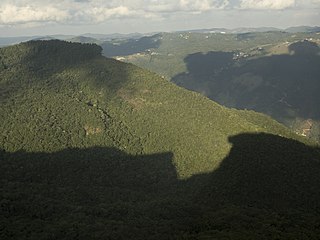Location
The protected area in the Cerrado biome, which covers 131,769 hectares (325,610 acres), was created on January 26, 1990. It is administered by the Chico Mendes Institute for Biodiversity Conservation. It contains all or part of the municipalities of Conceição do Mato Dentro, Itabira, Itambé do Mato Dentro, Jaboticatubas, Nova União, Morro do Pilar, Santana do Riacho and Taquaraçu de Minas in the state of Minas Gerais.

The Chico Mendes Institute for Biodiversity Conservation is the Brazilian Ministry of the Environment's administrative arm. It is named after the environmental activist Chico Mendes.

Conceição do Mato Dentro is a Brazilian municipality located in the state of Minas Gerais. The city belongs to the mesoregion Metropolitana de Belo Horizonte and to the microregion of Conceição do Mato Dentro.

Itabira is a Brazilian municipality and a major city in the state of Minas Gerais. The city belongs to the Belo Horizonte metropolitan area mesoregion and to the Itabira microregion.

The Grande Sertão Veredas National Park is a national park located on the border between the states of Minas Gerais and Bahia, Brazil.

The Serra do Cipó National Park is a national park in the state of Minas Gerais, Brazil.

Serra da Bodoquena National Park is a national park in the state of Mato Grosso do Sul, Brazil.

Barra do Rio Mamanguape Environmental Protection Area is a protected area of 14,640 hectares in the estuary of the Mamanguape River in the state of Paraíba, Brazil.

Petrópolis Environmental Protection Area is a protected area of Rio de Janeiro state, Brazil.

Piaçabuçu Environmental Protection Area is a protected coastal area in the state of Alagoas, Brazil.

The São Bartolomeu River Basin Environmental Protection Area is a protected area near Brasília, the capital of Brazil.

The Descoberto River Basin Environmental Protection Area is a protected area in the basin of the Descoberto River, which provides a large part of the water supply to Brasília, the capital of Brazil.

Cairuçu Environmental Protection Area is a protected area in the south of Rio de Janeiro state, Brazil. It contains an important remnant of the Atlantic Forest biome.

Serra da Mantiqueira Environmental Protection Area (Portuguese: Área de Proteção Ambiental da Serra da Mantiqueira is a protected area of Brazil that includes parts of the states of Minas Gerais, Rio de Janeiro and São Paulo.

Guaraqueçaba Environmental Protection Area is a protected area in the State of Paraná, Brazil. It includes Atlantic Forest, mangrove, salt marsh and estuarine environments in an area with a relatively low human population.

Igarapé Gelado Environmental Protection Area is a protected area in the state of Pará, Brazil. It contains cultivated land and Amazon biome.

Cavernas do Peruaçu Environmental Protection Area is a protected area in the state of Minas Gerais, Brazil.

Carste de Lagoa Santa Environmental Protection Area (Portuguese: Área de Proteção Ambiental Carste de Lagoa Santa is a protected area in Minas Gerais, Brazil.

Serra de Tabatinga Environmental Protection Area is a protected area in the state of Tocantins, Brazil. It is in the Cerrado biome.

Ibirapuitã Environmental Protection Area is a protected area in the state of Rio Grande do Sul, Brazil. It contains the pampas biome.

The Nascentes Geraizeiras Sustainable Development Reserve (Portuguese: Reserva de Desenvolvimento Sustentável Nascentes Geraizeiras is a sustainable development reserve in the Cerrado ecoregion within the state of Minas Gerais, Brazil.

The Mananciais do Rio Paraíba do Sul Environmental Protection Area is an environmental protection area in the state of São Paulo, Brazil.

The Delta do Parnaíba Environmental Protection Area is a federally-administered environmental protection area that covers parts of the coasts of the states of Maranhão, Piauí and Ceará, Brazil.

The Serra da Ibiapaba Environmental Protection Area is an environmental protection area in the states of Piauí and Ceará, Brazil. It contains fragments of cerrado, caatinga and Atlantic Forest, and is home to the endangered red-handed howler.
This page is based on this
Wikipedia article Text is available under the
CC BY-SA 4.0 license; additional terms may apply.
Images, videos and audio are available under their respective licenses.




















